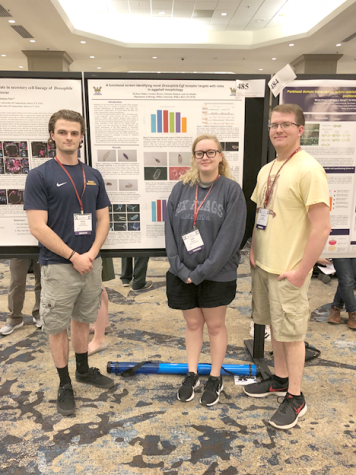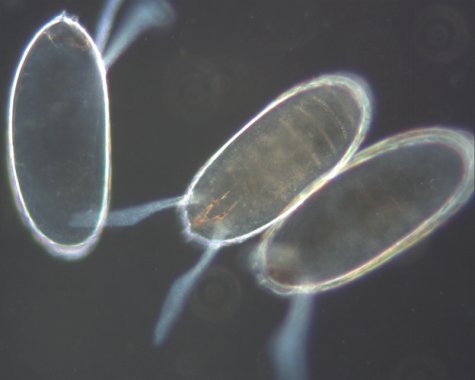Biology professor, students study the early development of fruit flies
A Wilkes University research team, led by Dr. Lisa Kadlec, associate professor of biology, is studying fruit flies in order to better understand the early development of many different organisms including humans.
The team has been accomplishing this by investigating how certain genes affect the physical characteristics of fly eggs and what happens when these genes are mutated.
But it isn’t just genetics that is being studied: the role of cell signaling in the early development of flies is also a core component of this research.
Cell signaling, as the name suggests, refers to the variety of methods by which cells signal each other to communicate. This is a vital process for multicellular organisms such as humans, where trillions upon trillions of cells need to be able to “hear from” one another and from their surrounding environment in order to function correctly.
Such processes are often observed as part of signaling “pathways” as large numbers of cells “talk” to each other in a specific order to coordinate for a specific purpose.
The pathway being studied here is called the EGFR pathway, so named because it is driven by EGF (Epidermal Growth Factor) receptors responding to certain chemical signals. This signaling affects cells by influencing gene expression, meaning that certain genes that determine physical features and development are switched “on” or “off” as a result of this pathway.
“These are genes whose function during development was previously unknown,” said Kadlec. “Interestingly, we have found that they appear to be important for proper egg morphogenesis (i.e. proper structure and shape of the eggshell and respiratory appendages) as opposed to proper patterning (i.e. correct location of features). This is interesting because EGFR signaling has long been known to be important for patterning.”
However, the implications of this research extend far beyond fruit fly eggs.
“This signaling is important for the normal development of everything from worms to flies to human beings. This research will help us to understand the range of genes turned on by EGF receptor signaling, and the way that these genes impact normal development, and may also give us insight into the implications of abnormal signaling which is involved in a variety of diseases including cancer,” added Kadlec.
Investigating the effects of EGF receptor signaling is nothing new for Kadlec, she became involved in this area of study before even coming to Wilkes, when she was a post-doctorate fellow at Princeton. However, the study focusing on fly eggs specifically only dates back to 2015, when biology majors Michael Warkala and John Nawrocki initiated the research for their senior projects.
The Wilkes biology majors that have come after them have continued their work.

Nick Hudock, Corinne Brown and Zach Walter at last year’s Drosophila Research Conference.
One of those students is Molly Yuschock, who has been working under Kadlec since her early days at Wilkes.
Describing how she first got involved in studying fly genetics, Yuschock said, “ I sat in on one of Dr. Kadlec’s classes the spring before I started college. Then when I met her at the Biology Meet & Greet in the fall I decided I wanted to learn more about her research so I started observing and volunteering in the lab. I was always interested in genetics and research so I thought her lab would be a good fit. I joined the lab last fall so I’ve been assisting on the project for about a year.”
How does this research happen?
Naturally, it all begins with a group of flies. The flies are placed in a “laying block,” made up of several tubes suspended over an agar plate filled with fruit juice. Flies are separated into different tubes, but they all ultimately lay their eggs on the agar plate.

An image of normally developed fruit fly eggs observed under a microscope.
The newly laid eggs are then promptly collected and inspected under a microscope. Sometimes, the shells will look perfectly normal, but other times they may appear underdeveloped or look as though they’ve been punched and shattered. The variations in egg quality all tie back to the genes which underlie these experiments.
The team uses several varying methods to find and analyze which genes are expressed in the developing flies, most importantly in their developing ovaries, however, one of their most standard procedures is to use a technique called in situ hybridization to label a gene of interest’s RNA, which acts as a messenger and translator for genetic information, with a special probe.
Through this method, it can be determined whether a studied gene is being expressed in the ovary. More recently, the research group has been using a gene modification tool called CRISPR cas9 to create mutations in the studied flies by cutting and altering strands of DNA. This allows the team to see what happens to the fly eggs when specific genes have been removed or deactivated.
Kadlec and a group of undergraduate research students present progress in this study every year at the annual Drosophila Research Conference (Drosophilia being the scientific name for fruit flies). These presentations date back to 2009 before this current round of research even began.
Corrine Brown, a biology major who’s been working on the EGF signaling project for about a year, talked briefly about her experiences at this conference.
“Presenting at conferences is terrifying, but so rewarding. The Annual Drosophila Conference is mostly post doc or people with PhDs. Almost everyone there knows more than me. But being able to show off my knowledge and what we do is a great feeling.”
There is no definite end date for this study, as there are still several genes that need to be researched further. Kadlec and her team are, however, currently in the process of writing a scientific paper centered on the work begun by Warkala and Nawrocki.